#enrico forestieri
Explore tagged Tumblr posts
Text
Little Questions

L’anno scorso Matteo Pace ed io abbiamo riflettuto brevemente sul fenomeno dei little magazine di architettura. Questo articolo forma parte di Clip Stamp Upload, ampia e variate raccolta di contributi selezionati da Luigi Mandraccio (Burrasca) e Gianluca Porcile (ICAR 65).
El año pasado, Matteo Pace y yo hemos reflexionado sobre el tema de los little magazine de arquitectura. Este artículo está incluido en Clip Stamp Upload, amplia y variada recolección de contribuciones seleccionadas por Luigi Mandraccio (Burrasca) y Gianluca Porcile (ICAR 65).
Last year Matteo Pace and I have briefly reflected upon architecture little magazines. This article is now part of Clip Stamp Upload, a wide and varied volume edited by Luigi Mandraccio (Burrasca) e Gianluca Porcile (ICAR 65).
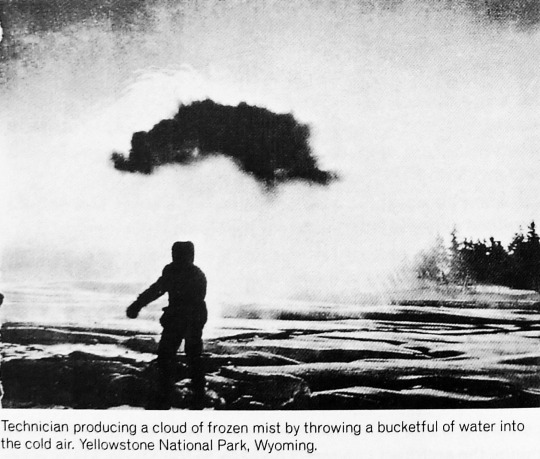
Qui l’introduzione:
Assistiamo ormai da un decennio alla proliferazione di riviste indipendenti (little magazine) di architettura: un rinnovato interesse e una vitalità in decisa controtendenza rispetto allo stato comatoso del settore della costruzione. Un'attitudine maggiormente speculativa e riflessiva è tratto comune alle fasi recessive, come quelle attraversate negli anni Sessanta e Settanta1. Ma questa pre-condizione, da sola, non basta a far luce sull'improvviso revival dei little magazine architettonici.
Il vigore di questa ripresa è anche legato a due importanti operazioni culturali di diversa rilevanza critica che, in modo distinto, sono riuscite a riaccendere i riflettori su fanzine e pubblicazioni radicali: Clip, Stamp, Fold: the Radical Architecture of Little Magazines 196X to 197X, promosso da Beatriz Colomina e Craig Buckley, e Archizines, ideato da Elias Redstone.
Il primo documenta e sistematizza il vasto ed eterogeneo panorama dell'editoria radicale tra gli anni Sessanta e Settanta. Evidenzia le influenze reciproche tra le diverse esperienze e propone acute chiavi interpretative di un fenomeno storico tanto eterogeneo e sfuggente. Questa ricerca, nata in ambito accademico (Princeton University), è stata ampiamente promossa a scala globale2 attraverso una serie di mostre e dibattiti (2006-2007) poi confluiti nel libro omonimo (2010)3.
Elias Redstone intercetta questo fermento e nel 2011 propone con Archizines un archivio on line dei little magazine cartacei contemporanei; offre a tutti i selezionati la “consacrazione” archivistica in presa diretta e allo stesso tempo la pagina web funge da volano alle mostre itineranti realizzate negli anni successivi4.
Ma in cosa differiscono le pubblicazioni odierne dalle precedenti esperienze? Hanno ancora la stessa rilevanza?
Qui trovate il testo completo
Aquí, podéis leer el texto completo
Here, the complete text
...
Note:
1 Una simile attitudine si riscontra anche negli anni 60 e 70. Ad esempio, Robin Middleton in Clip Stamp Fold commenta: The possibility of doing much in architecture was minimal. ... There just weren't the clients. I know there were grand houses going up in America or in France, but generally architecture was a miserable profession to be in (p. 31). E ancor più chiaramente in risposta a Daniel López Perez (DLP): One of the differences that we were encountering between Europe and the East Coast particularly in the States is that during a recession was actually when architects and magazines were being most speculative because, in fact, building industries and practices weren't taking people's time. Did you sense this difference? RM: Well obiouvsly during the period of recession you've got more time to play (p. 32).
2 Tra le sedi di mostre e dibattiti ricordiamo: Storefront Gallery, New York; Canadian Centre for Architecture, Montreal; Arch+ Documenta Magazines, Kassel; Architectural Association, London; Norsk Form, Oslo; Contemporary Art Gallery, Vancouver; Disseny Hub, Barcelona; Colegio Oficial de Arquitectos de Murcia, Murcia, Bureau Europa/NAI, Maastricht
3 A cura di Beatriz Colomina, Craig Buckley (2010), Clip, Stamp, Fold: the Radical Architecture of Little Magazines 196X to 197X, Barcelona, Actar.
4 Caroline Gaimari (2014), “Interview with Elias Redstone” in Purple Magazine, issue n. 21: ER: I originally presented the project online with the aim of curating an exhibition to make people aware of all the creativity coming out of architectural publishing today. I approached the Architecture Foundation in London and Storefront for Art and Architecture in New York… Two years in, it may be the most toured exhibition about architecture ever! in http://purple.fr/article/elias-redstone/, ultimo accesso 2 Aprile 2016.
#Little questions#enrico forestieri#matteo pace#CSU#clip stamp ulpoad#independent#editorial practice#little magaziones#fanzine#architecture
1 note
·
View note
Photo

Comune di Bugliano 🔴 CHIESA DI BUGLIANO: SCRITTE INGIURIOSE CONTRO IL VATICANO "È evidente" - ha spiegato il parroco arrabbiato - "Che la scritta in questione è da ricollegarsi alla questione del Ddl Zan e della contrarietà del Vaticano." Suor Marika, mentre consolava il parroco, ha aggiunto: "Non capisco perché se la prendano con Don Enrico che, nel 2020, ha celebrato 4 matrimoni gay. Qui a Bugliano non c'è discriminazione da parte di nessuno" I carabinieri non escludono che gli autori del gesto siano forestieri.
27 notes
·
View notes
Text
L'impatto culturale del drago Tarantasio sul terziario italiano
(un sentito ringraziamento al buon Enrico per avermi fatto precipitare in questo buco nero)
Fra il letto dei fiumi Adda e Serio ci sono tante cose, ma non c'è un lago. Anzi, "datazioni geologiche permettono di rilevare che già 5000 anni fa la valle dell'Adda era già formata, e si presentava così com'è ora.". Da dove viene questa citazione? Dalla pagina di wikipedia del Lago Gerundo. Che non c'è. E non c'era, se ti fidi delle fonti storiche e della geologia. Dice che è "conosciuto più per la tradizione orale". La mia ipotesi è che qualche ganzo in pantacalze medioevali abbia portato una sera la sua sfitinzia a parcheggiarsi imboscati col carretto, e davanti ad alcune rimostranze estetico-paesaggistiche "ma mi hai portato in un ghiaione" ella sia stata turlupinata vilmente tipo "sì ma qui una volta c'era un lago, immagina, puoi" e la storia si sia poi diffusa.
Comunque: abbiamo una zona di strati di ghiaia, ricoperti da mediamente 45 cm di torba, che è tale da 5000 anni ed è nota come Lago Gerundo. Non avevo un mal di testa così dalla descrizione degli occhiali-non-occhiali di lapo che non sono occhiali ma è un concetto.
Ma prendiamolo come lago assiomatico. Nelle sue acque-non-acque pare vivesse un drago (forse la prima storia su questi animali nella quale la loro esistenza è la parte più plausibile): il terribile drago Tarantasio.
Si riteneva che divorasse i bambini, che fracassasse le barche ed il suo fiato pestilenziale ammorbava l'aria e causava una strana malattia denominata febbre gialla.
Non me ne voglia la Tradizione Orale™ ma quando ti ritrovi una bestia che si ciba di cristiani, distrugge i barchini e soffre di alitosi tossica magari si sarebbe potuto scegliere un nome più temibile di Tarantasio, che suona un po' come "il serial killer Sbirulino".
Comunque qualcuno ad un certo punto arrivò, accoppò il drago e già che c'era bonificò il lago (credo fosse l'equivalente del XII secolo delle garanzie aggiuntive che ti offrono nelle catene di elettrodomestici "per diciannove ducati e novanta oltre alla disinfestazione draghi vi prosciughiamo anche il lago, se torna entro cinque anni vi mandiamo un altro cavaliere"). Sull'autore dell'impresa ci sono più ipotesi: san Cristoforo, Federico Barbarossa ma quella che ci piace di più è Umberto Visconti, che dopo l'impresa usò il drago per lo stemma della casata.
Poi i pittori di stemmi di casate di draghi ne han visti pochini quindi venne stilizzato un serpentone con le scaglie e probabilmente fu Umberto stesso a dirgli "cristosanto mettigli un essere umano in bocca o sembra una biscia del boschetto qui dietro". In realtà sullo stemma dei Visconti le ipotesi sono svariate, potrebbe citare il Nehustan scolpito nella basilica di sant’Ambrogio a cui poi è stato aggiunto un saraceno a caso in bocca in tempi di salvin crociate. Ma questo blog dice NO ai rettili forestieri, e riteniamo più plausibile come ispirazione l'italico vigore del drago Tarantasio.
Nel tempo, la sovraesposizione a secoli di stemmi viscontei in castelli, duomi, mausolei e stazioni dei treni ha condizionato le docili menti dell'imprenditoria industriale italiana che ne ha abusato in loghi assortiti fra Alfa Romeo, Eni, Milano 2, canale 5 e fininvest in generale che però ha optato per una versione soft col biscione che ogni tanto mangia un fiore perché l'appalto sul cibarsi di bambini è poi stabilmente passato nelle mani dei comunisti.
E ora ogni volta che vedo uno di quei loghi lì non posso fare a meno di pensare al terribile drago Tarantasio e all’omarino medioevale in pantacalze che ciurmava la sua bella con storie di laghi rinsecchiti.
20 notes
·
View notes
Text
La Collera, "La Collera": recensione e streaming
La Collera, “La Collera”: recensione e streaming
La Collera, band milanese figlia dell’itpop, presenta il suo primo, omonimo ep, distribuito da Alka Record Label. I membri della band sono quattro musicisti (Giovanni Linke Casalucci, Giannandrea Forestieri, Alessandro Pisu ed Enrico Buttafuoco) con gusti ed esperienze diverse, che hanno fatto della loro eterogeneità un punto di forza.
Si avverto influenze che hanno definito il loro stile,…
View On WordPress
0 notes
Text
Sabato 6 aprile 2019 viene inaugurata la nuova caserma dei Carabinieri in Trezzo, trasferendone a titolo definitivo la stazione da via Medici a via Nenni. Invocata fin dal 1860 e personalmente richiesta a Giovanni Giolitti, l’Arma s’insedia in paese nel 1908. A oltre un secolo da quella data così antica, hanno presenziato alla nuova inaugurazione: il Generale di Brigata Antonio De Vita, Comandante la Legione dei Carabinieri “Lombardia”; il Colonnello Luca De Marchis, Comandante Provinciale dei Carabinieri di Milano; il Dott. Giacomo Pintus, Vice Prefetto di Monza e il Dott. Francesco Aldo Umberto Garsia, Vice Prefetto di Milano; il Capitano Antonio Stanizzi, Comandante la stazione di Vimercate; il Tenente Colonnello Simone Pacione, oggi Comandante del Comando Provinciale di Monza; il Deputato Massimiliano Capitanio, nativo di Vimercate e già apprezzato Caporedattore in alcune testate locali.
Uno scatto dell’inaugurazione (Foto Rino Tinelli)
Con decreto ministeriale del 22 agosto 1862, la caserma dei Reali Carabinieri di Vaprio è trasferita a Trezzo, dove i pubblici Amministratori lamentano «lo spirito litigioso e sovversivo di questa popolazione». Il 26 marzo dell’anno dopo, il provvedimento viene sospeso: l’Arma si concentra al Sud nella lotta al brigantaggio e, per scarsità di uomini, non può riformare al nord le proprie stazioni. Il comune trezzese offre comunque alcuni locali all’insediamento dei Carabinieri, perché in paese la Guardia Nazionale non basta più a garantire la pubblica sicurezza. «Nel mentre i Militi si pigliavano la ricompensa, non badavano al loro dovere, e ciò pel motivo semplicissimo che essendo tutti o parenti od amici, nessun voleva denunciare per non essere denunciato alla sua volta – riferisce il consiglio comunale nel 1864 – La giunta cercò sempre che i Reali Carabinieri fossero stazionati nel Comune […] e in questo soltanto vede un’ancora di salvezza contro la crescente immoralità». Solo l’imparzialità dell’Arma può rimediare al servizio dei Militi, tanto domestico e parziale che «i reati si moltiplicarono, semplici furti divennero grassazioni e rapine a mano armata, le minacce passarono a gravi e pericolosi ferimenti con attentati benanche alla vita dell’autorità nell’esercizio delle sue funzioni».
AsMi, Dettaglio di carteggio con la Divisione di Milano circa l’erezione della caserma trezzese (Fondo Prefettura)
La crisi agraria degli anni Settanta e l’avvio delle industrie paesane muovono masse tali da compromettere la tenuta dell’ordine pubblico. Con instancabile fiducia, dal 1862 al 1908 il municipio invoca perciò che l’Arma insedi a Trezzo una stazione. Ogni sindaco percorre ipotesi diverse: il paese abbia almeno una caserma provvisoria; traslochi altrimenti qui la brigata di San Gervasio, quella di Cassano o Vaprio. La politica locale ottiene solo che quest’ultima rinforzi l’organico per esercitare una speciale sorveglianza sulla vicina Trezzo. Nel giugno 1901, giungono qui da Vaprio alcuni agenti «durante il non breve periodo dello sciopero scoppiato in questi contadini, a scanso di disordini ed a salvaguardia della privata proprietà». Ai Carabinieri il comune ospitante provvede due vetturali, Antonio Ciocca e Luigi Minelli, oltre al vitto con alloggio presso il «Tre Re» di Enrico Presezzi o l’«Albergo Trezzo» di Rinaldo Redaelli. Anche l’11 e il 7 agosto seguente, solennità patronale di San Gaetano, «vi fu tale affluenza di forestieri in Comune da rendere necessario l’intervento di 5 Carabinieri», cui il consiglio comunale approva 40 Lire di spesa per i pasti e l’accoglienza.
Rinaldo Redaelli
Trezzo rivolge a Giolitti la richiesta di una stazione dei Carabinieri
«Passarono infruttuosamente ormai 42 anni […] – il sindaco trezzese lamenta al prefetto nel 1902 – Se in questo comune il desiderio di avere la stazione dei Reali Carabinieri era fortemente sentito fin dal 1860 (abitanti 3.500), oggi che la popolazione è salita a 5.353 abitanti, un tale desiderio si è trasformato in imperiosa necessità». Per indurre l’apertura di caserma, il primo cittadino espone come Trezzo ferva di industrie, negozi, tram e mercato; inoltre, il breve trasporto a Brembate della stazione di San Gervasio sguarnisce la sorveglianza del ponte sull’Adda. «L’acqua potabile, la luce elettrica e i Carabinieri sono tre problemi che da molto tempo si impongono a questa autorità comunale». La caserma è ormai un servizio indispensabile ma le possibilità di installarla sono talmente basse che il nuovo sindaco Luigi Galbiati decide di mirare alto: ricorre al deputato conte Andrea Sola Cabiati, perché illustri confidenzialmente in Roma la questione trezzese al sottosegretario Scipione Ronchetti e persino a Giovanni Giolitti, presidente del consiglio dei ministri. Già il 18 dicembre 1904, votando per integrare 3.000 uomini all’Arma, Sola incontra il leader politico in aula e gli caldeggia l’istituenda caserma di Trezzo. Mancano tuttavia gli estremi d’urgenza per una nuova stazione dei Carabinieri. Quella vapriese si allaccia intanto al centralino di Cassano, cui Trezzo deve rivolgersi telefonicamente, aggravando le tariffe di chiamata.
Giuseppe Rolla
È infine Giuseppe Rolla (1850-1918), imprenditore tessile e sindaco, a ottenere la sospirata caserma nel 1908. Già dal gennaio 1907 rivolge parole irrevocabili alla prefettura milanese: «Coll’erezione del nuovo ponte e col sorgere di nuove industrie, i vicini comuni di Capriate, San Gervasio e Grignano (abitanti 3.773) vennero per infiniti interessi di lavoro e negozio, a formare con Trezzo, si può dire, una sola borgata (abitanti 9.116) co’ suoi vantaggi, è vero, ma altresì co’ suoi danni per la pubblica sicurezza […] Il grandioso impianto idroelettrico [oggi Enel “Alessandro Taccani”], lo sviluppo preso da altre industrie, piccole e grandi, la linea tramviaria, chiamarono in luogo uno straordinario numero d’operai dal contado milanese e veneto, cosicché la popolazione ascese ad oggi a 6.800». In paese si censiscono 180 esercizi, di cui 49 pubblici: oltre i due terzi della cittadinanza sono operai, benché all’anagrafe figurino contadini.
Documento della stazione dei Carabinieri di Trezzo (Raccolta Rino Tinelli)
«Qui c’è il convegno di tutti i birichini, i scavezzacolli d’ambo i sessi, e dei pregiudicati anche dei paesi vicini. A far fronte a tutta questa accozzaglia di gente non vi sono – quando vi sono, al sabato, alla festa ed al lunedì sera – che due poveri diavoli di Carabinieri, i quali già stanchi all’arrivo – perché la stazione dista 5 chilometri circa e sono sprovvisti di bicicletta – devono affaticarsi per l’ampio abitato e far l’impossibile […] Non solo, nella seconda metà dell’anno 1905 avvennero due grandiosi incendi, non si potette avere un Carabiniere […] Ma ciò che rattrista ed impensierisce sono i furti, i ferimenti (di cui 5 noti ed impuniti dall’8 settembre al 3 dicembre del corrente anno) e delitti d’ogni genere che restano ignoti […] è umiliante che una popolazione buona ed attiva, come quella di questo paese, sia quasi alla mercé di un manipolo di teppisti e di pochi farabutti».
L’ex-oratorio di Santa Marta, sede storia dei Carabinieri a Trezzo (Foto Rino Tinelli)
Malgrado le rassicurazioni prefettizie, la caserma non viene accordata: Giuseppe Rolla e l’intera giunta comunale minacciano allora le dimissioni, informandone l’onorevole Sola con l’appoggio del senatore Silvio Benigno Crespi. Il timore di uno scandalo politico smuove finalmente la pratica, aperta da quasi mezzo secolo: la stazione dei Reali Carabinieri si insedia a Trezzo entro il 20 giugno 1908 quando, in esito alla nuova apertura, viene abolita la vecchia caserma di Cornate. Nel 1911 «per quanto un costruendo impianto della Edison [oggi “Carlo Esterle”] possa portare un aumento di operai in quella plaga, non si ritiene per nessuna ragione il caso di ripristinare la soppressa stazione di Cornate. A tale proposito venne sino dall’inizio dei lavori disposto che quasi giornalmente due militari si rechino di servizio sui luoghi del nuovo impianto tanto più che la forza della stazione di Trezzo è di otto militari compresi due sottufficiali». Così nel 1911 scrive al ministro il capitano comandante la divisione di Milano esterna, quando la caserma trezzese è ancora retta da un brigadiere.
Il maresciallo Giuseppe Minella
Promossa a sede di maresciallo, Trezzo accoglie in questa dignità: Gennari entro il 1924; Giuseppe Minella (1889-1936) prima del 1928; e più tardi Salvatore Migliaccio. Oltre che presso la dismessa Casa del Fascio (già casa dell’ing. Agostino Perego e oggi sede della Polizia Locale), la stazione tiene storico domicilio nell’oratorio sconsacrato di Santa Marta, presso l’omonima porta del borgo. L’edificio conferma l’uso militare lungo la Seconda guerra mondiale quando, nel novembre 1943, alcuni partigiani sono imputati di aver affisso manifesti antifascisti. L’intervento di un appuntato dei Carabinieri, contrario al regime, riduce a multa per schiamazzi notturni l’accusa altrimenti pendente di attività sovversiva. Sulla via che porta oggi il suo nome, l’avvocato poeta Luigi Medici (1888-1965) devolve pubblicamente la proprietà dove progetta una struttura per anziani. Sospeso, il cantiere si compie a uso di nuova caserma, da cui i Carabinieri trezzesi trasferiscono all’attuale sede di via Nenni.
Luigi Medici con la madre Teresa Crespi
Fonti. Archivio Comunale di Trezzo: Storico, 26/508; Moderno, 191. Archivio di Stato di Milano: Prefettura, Gabinetto, I versamento, 187 e 188. Cristian Bonomi, Laura Businaro, Gabriele Perlini, Incroci di vite, Trezzo 2019, edizione on-line, pp. 97-98; Romano Leoni (a cura di), Antifascismo e Resistenza a Trezzo 1943-1945, Vaprio d’Adda 2000, p. 68. Bollettino ufficiale dei carabinieri reali, Roma 1908, p. 58. Giornale militare ufficiale, Roma 1874, p. 306. Carlo Giacomo Boisio, Luigi Medici, Milano s.d., pp. 172-174. Ringrazio Lorenzo Bassi; il Luogotenente Marco Bennati, comandante la stazione di Trezzo; Silvia Bonomi (Archivio Comunale di Trezzo sull’Adda), Alberto Rolla (Archivio famiglia Rolla) e Rino Tinelli (Raccolta Tinelli).
Dall’Informatore Comunale La Città di Trezzo sull’Adda – Notizie, 2019, I
#gallery-0-4 { margin: auto; } #gallery-0-4 .gallery-item { float: left; margin-top: 10px; text-align: center; width: 33%; } #gallery-0-4 img { border: 2px solid #cfcfcf; } #gallery-0-4 .gallery-caption { margin-left: 0; } /* see gallery_shortcode() in wp-includes/media.php */
Il Comandante Marco Bennati davanti alla nuova stazione dell’Arma di Trezzo su via Nenni (Foto Rino Tinelli)
La nuova caserma dell’Arma di Trezzo su via Nenni (Foto Rino Tinelli)
Da sinistra: il Luogetente Marco Bennati, il dott. Francesco Aldo Umberto Garsia (Vicario-Coordinatore del Prefetto di Milano), il sindaco trezzese Danilo Villa, il Generale di Brigata Antonio De Vita (Comandante la Legione dei Carabinieri “Lombardia”) e il prevosto Don Alberto Cereda convenuti alla cerimonia (Foto Rino Tinelli)
La consegna di rito tra sindaco e Comandante della stazione (Foto Rino Tinelli)
Il taglio del nastro: da sinistra il prevosto trezzese Don Alberto Cereda, il Generale di Brigata Antonio De Vita (Comandante la Legione dei Carabinieri “Lombardia”), il dott. Francesco Aldo Umberto Garsia (Vicario-Coordinatore del Prefetto di Milano) e il sindaco trezzese Danilo Villa (Foto Rino Tinelli)
La benedizione (Foto Rino Tinelli)
Tra le autorità intervenute alla cerimonia: da sinistra, il Deputato Massimo Capitanio, il Generale di Brigata Antonio De Vita (Comandante la Legione dei Carabinieri “Lombardia”), il sindaco Danilo Villa e il Luogotenente Marco Bennati (Foto Rino Tinelli)
La refezione presso le scuole medie di Trezzo (Foto Rino Tinelli)
Uno scatto dell’inaugurazione (Foto Rino Tinelli)
Carabinieri, dal 1908 un’Arma per la pace dei Trezzesi Sabato 6 aprile 2019 viene inaugurata la nuova caserma dei Carabinieri in Trezzo, trasferendone a titolo definitivo la stazione da via Medici a via Nenni.
#Andrea Sola Cabiati#Arma#caserma Brembate#caserma Cassano#caserma Cornate#caserma San Gervasio#caserma trezzo#caserma Vaprio#comandante Bennati#Danilo Villa#don Alberto Cereda#Giovanni Giolitti#giuseppe minella#Guardia Nazionale#luigi galbiati#Luigi Medici#luogotenente Bennati#Marco Bennati#Massimiliano Capitano#Salvatore Migliaccio#Scipione Ronchetti#silvio benigno crespi#storia Arma#storia Carabinieri#storia caserme Carabinieri#Trezzo
0 notes
Photo



Cappello Ferorelli Mandraccio Porcile
CSU in Motion
“CSU in Motion” is a new stage of “Clip Stamp Upload”, a format about independent architecture magazines curated since 2015 by Burrasca and ICAR65 in Genoa for the Architects’ Professional Association Foundation and organized by Luigi Mandraccio and Gian Luca Porcile.
For this year’s edition, the curatorial team is enlarged, involving Fabio Cappello and Rossella Ferorelli, while CSU moves to Venice, taking part in the Unfolding Pavilion, where the format will include a talk with activists and experts from the editorial world of architecture who, on May 27th, will discuss the state of art. The confrontation between new practices and established protagonists will bring to light the recurring topics of the sector and, at the same time, the changes and transition occurred in the last years, particularly connected to the evolution of media.
The talk will be staged inside a background exhibition of collages realized by several young practitioners using graphic material from a wide collection of recent independent editorial works. They started from a dossier collage that collects critical contributions about the visual culture of collage from more than 25 Italian engaged architects, critics and experts, opening up the debate for further developments, including publication.
The event will also have a live online presence, as some of the guests will be asked to join an experimental cross-media live posting session based on Instagram.

Keynote discussant: Beatriz Colomina
Round table: Accattone, Alfa, Amor Vacui Studio, Argonauti, BLITZ Archimagazine, Carnets, Ermanno Cavaliere, CHIASMO, Conformi, Devenirs, Etaoin Shrdlu, Enrico Forestieri, From outer space, Argenzia Cristina Gallotta, Alberto Benetti Genolini, Järfalla, Malapartecafè, Giulia Ricci
Fabio CAPPELLO is M.Arch (DiARC - University of Study of Naples ‘Federico II’), assistant at DiARC and at the international seminar Villard de Honnecourt. Cappello is a licensed architect, co-founder of PROFFERLO architettura, curator at SPONTANEOUS, editor of Chiasmo (leaflet about Neapolitan architecture) and architectural photographer. He collaborated with Domus, Temporary Office, Milan Arch Week and the Venice Architecture Biennale.
Rossella FERORELLI obtained a PhD at the Politecnico di Milano with Luca Molinari, with a thesis about the transformation of publicness in the built urban environment of the postdigital society. Since 2011, she is a founding member of SMALL - Soft Metropolitan Architecture & Landscape Lab, an architecture office and open platform based in Bari and Milan, investigating on the contemporary urban condition both through design and forms of parallel research, hybridizing the curatorial practice with independent publishing and academic experimentation.
Luigi MANDRACCIO is an architect and a Ph.D candidate at dAD, Polytechnic School of Genoa and his research is focused on scientific mega-structures. He is part of the editorial board of the international books series Burrasca that he founded in 2013. He co–curated the 2015 and 2016 edition of the symposium “Clip Stamp Upload” about independent publishers on Architecture. Besides publishing some articles and essay, he co-edited: CSU Editoria indipendente di architettura nei seminari Clip Stamp Upload, and Temporary Office. First act. Il Mercato del Pesce di Genova (2017, Sagep).
Gian Luca PORCILE received his PhD in Architecture from the University of Genoa in 2011. His main research interests are the influences of natural patterns on architectural theory and urban development. He is a founding member of the Multidisciplinary Research Group ‘ICAR65′. He teaches History of Architecture at the department of Architecture-Design (dAD) of the University of Genoa.
CSU in Motion. Event. Round table & discussion. Sunday, May 27th 2018, 10:00 - 13:00.
Illustrations: © Unfolding Pavilion, AIT, atelier XYZ. >
0 notes
Text
Italian Espresso Reimagined At Milan’s Orsonero Coffee
Milan is a city known for fashion and style, art and culture, aperitivos and cocktails. But coffee? Not so much. There are countless opportunities to order espresso in Milan, but is it always worth drinking? I’m Italian, but after many years of living in London, my taste for coffee has changed. I prefer a lightly roasted, fruity, and acidic coffee to a bold, dark-roasted Italian-style espresso. I recently traveled to Milan and, in my quest for specialty espresso, I was pointed in the direction of Orsonero Coffee, a newly opened cafe near Porta Venezia and the shopping district of Corso Buenos Aires.
It’s been two years since I was last in Milan to write about the second Italian AeroPress Championship. Back then, not many people here knew about specialty coffee. There were just a handful of cafes where you could have pour-overs and a choice of single-origin beans, most notably Taglio near the Navigli.
Since then, the Expo 2015 has come to Milan, bringing a breath of fresh air and innovation to the northern Italian city, together with a new wave of expats. Something has changed: It seems more cosmopolitan today than it ever was, even the locals feel it. The coffee scene is growing and so is the demand for specialty coffee, as I discovered after visiting Orsonero Coffee and chatting to its Canadian proprietor, Brent Jopson. Jopson and his wife, Giulia Gasperini, relocated to Milan from Vancouver, BC, in 2015 and, after noticing the lack of specialty coffee shops, decided to stay to open their own place.
The first thing to note about Orsonero Coffee is how the shop looks. Unlike other specialty coffee shops that have opened in Italy in recent years (such as Ditta Artigianale in Florence) but retain a traditional Italian cafe style, Orsonero looks and feels different. The aesthetic is minimalist, with white walls and light wooden tables. The menu is pared down: espresso-based drinks, filter, tea. There is food too, but only pastries and sandwiches from local suppliers. Here the focus is all about coffee.
“We wanted Orsonero to look like a specialty coffee shop you might find in any other global city,” says Jopson. “We took inspiration from cafes in my home city [Vancouver], northern Europe, and Japan, and our architects, Enrico Forestieri and Matteo Pace, were able to articulate our vision perfectly.” It’s true, Orsonero would make sense in Vancouver, Melbourne, or London and fit in perfectly. However, if you spend some time sitting in the cafe, drinking espresso, and watching locals drop by just to have a quick espresso at the counter, you feel 100 percent in Italy.
It all starts with the beans, which are roasted and blended by Italy’s top coffee roaster Rubens Gardelli. The choice of serving Gardelli Coffee was an easy one for Jopson, as he was keen to support the Italian specialty coffee scene. Gardelli, Italy’s Roasting and Brewers Cup champion, not only has the best coffee available but was also able to supply the type of lighter roast profile Jopson was looking for.
The house espresso is Cignobianco, Gardelli’s signature espresso blend. It’s made with two seasonal fresh-crop lots of specialty-grade Arabica (Brazil and Panama at the moment). It has the espresso taste that Italians love, without compromising on the quality of the beans and of the roast. “Italians are used to drinking espresso blends with quite a bit of Robusta so they’re not used to acidity you get from a lighter roasted third wave–style espresso,” Jopson says. “Cignobianco is perfect for us because it has a lot of sweetness, good body, and just the right amount of acidity. Our customers recognize it as an Italian espresso but still see that it’s something a little different.”
Orsonero also offers filter coffee on the Kalita and AeroPress, with two single-origin coffees to choose from (Gardelli beans for now, but Jopson plans to offer international guest coffees in the future). “We do around 5 to 10 pour-overs a day during the week and between 20 and 30 on Saturday. There is growing demand for filter coffee in Milan and I’ve noticed a lot of places are starting to offer pour-overs—not just coffee shops, but also ice cream shops, restaurants, etc.,” Jopson adds. “Maybe it’s just a trend. Filter coffee is interesting because Italians don’t seem to have any preconceptions about the price. You can sell a cup of batch brew for €3 and nobody complains.”
It’s a different story when it comes to espresso. A coffee ordered at the counter in Italy usually costs €1 and Italians aren’t easily convinced that it is worth paying more for it. Although a single espresso at Orsonero is €1.20 (just 20 percent above the average price), some customers have complained about it and even walked out of the cafe. “When one of our customers asks why our espresso is more expensive, I say it’s because we use 100 percent Arabica from a small-batch artisan roaster and that’s usually enough to convince most people,” says Jopson. “It’s funny because when foreign people come in they often say they can’t believe how cheap the coffee is.” Coming from London, that is exactly what I thought!
I order a flat white and sit at one of the small tables, observing the people in the cafe. There are groups of friends sitting at each of the other two tables and I even recognize a famous Italian TV presenter. I notice people coming and going, who order an espresso at the counter, drink it quickly while chatting to Brent and leave the bar within minutes. “Drinking coffee at the bar counter is something I really love about Italian coffee culture, so I am not trying to change that,” says Jopson. “We wanted to have low counters with the espresso machine on the front facing the customers so that I could interact with them while I’m making the coffee. I was worried that would discourage people from drinking at the bar, but it doesn’t seem to be a problem.”
Before leaving the cafe, I ask Jopson about the future of the Italian specialty coffee scene. Recent openings such as that of Faro in Rome and Estratto in Brescia have made me hopeful that things are changing in coffee in Italy, but is it really true? “The specialty coffee scene in Italy is growing, albeit slowly,” he says. “I don’t think we’re going to see a huge boom of specialty shops opening in the big cities like it has happened in other countries, but we will see a few more shops and maybe small roasteries opening in Milan and Rome in the next couple of years for sure.”
Orsonero Coffee is located at Via Giuseppe Broggi, 15, Milan. Follow them on Facebook and Instagram.
Giulia Mule is a Sprudge.com contributor based in London. Read more Giulia Mule on Sprudge.
The post Italian Espresso Reimagined At Milan’s Orsonero Coffee appeared first on Sprudge.
seen 1st on http://sprudge.com
0 notes
Text
Networks

What is the role architecture plays in the construction of the societies? This is the clear and direct question that Andrés Jaque (and his practice “Office for Political Innovation”) persistently asks himself for more than a decade. His buildings, installations, performances, teaching activities and texts unveil unexpected links between different subjects and processes (FrayFoam Home, 12 Actions to Make Peter Eisenman Transparent, House in Never Neverland), invert the conventional processes that build the city via a “revolution from the couch of your living room” (Tupper Home), generate controversies and arguments about the management of both public and private spaces (Arquitectura Parlamento, Polémicas de Interiores, Sweet Home Gran via) and convert infrastructures into catalysts for new social rituals (Cosmo PS1). Through the analysis of these projects, we will highlight the theoretical bases of Jaque's work (especially Bruno Latour and Michel Serres) and the strategies by which these are turned into architecture in a non-direct way.
















Look at and Download the slideshow at ISSUU
Presented by Enrico Forestieri at Newcastle University, Alternative Practive Theory APL 2001 (Prof. Andrew Law, Julia Heslop) 20170313
5 notes
·
View notes
Text
On Sophistication and Ambiguity

Over the last 15 years, the multinational developer Hines has undertaken the redevelopment of the whole area of Porta Nuova, Milan, a massive area partially abandoned for decades. With his project, Hines aims at projecting Milan far beyond the national scale to become a city worthy of the world stage where marketing and urbanism merge together. Facing such a vast and complex operation, the Municipality of Milan, has endorsed the project and this case study clearly shows the spatial repercussions of the disequilibrium stemming from public/private negotiations.
Within this redevelopment, Hines calls for Stefano Boeri to ‘legitimise’ the entire real estate operation and to tone down frictions with the citizens. His Bosco Verticale is a sophisticated and ambiguous operation where greenwashing, politics and architecture are inextricably intertwined.
During this session we will try to unveil the articulate and sometimes unexpected synergies between private investors and architects and to provide critical instruments to interpret such phenomena.

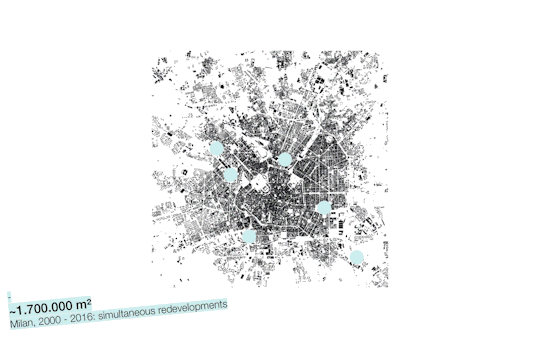




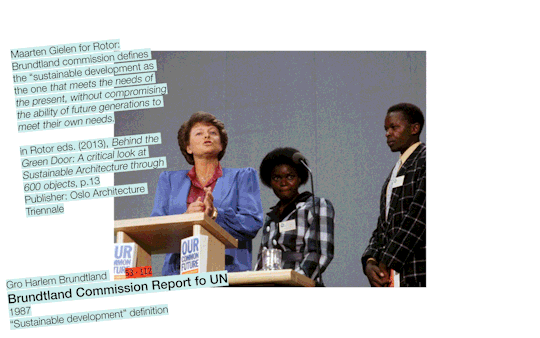


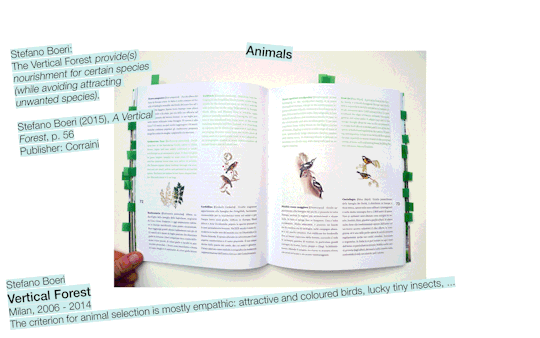
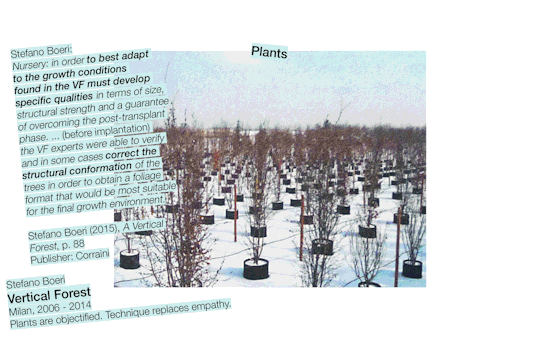
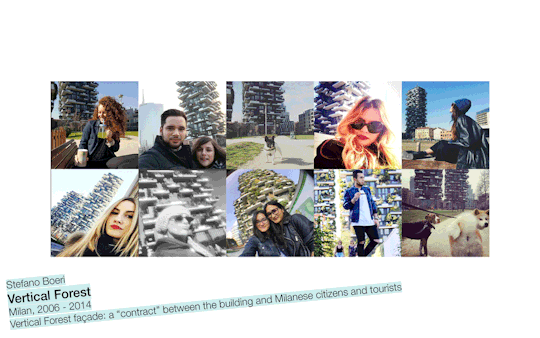
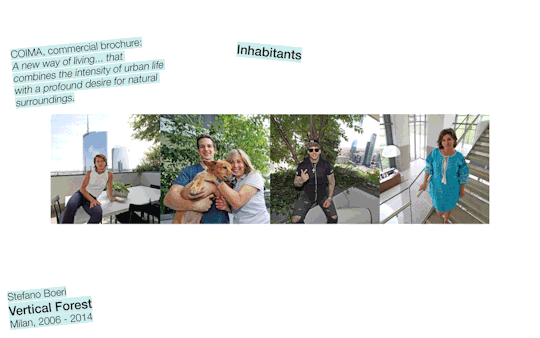


Look at and Download the slideshow at ISSUU
Presented by Enrico Forestieri at Newcastle University, Alternative Practive Theory APL 2001 (Prof. Andrew Law, Julia Heslop) 20170227
#Sophistication#ambiguity#enrico forestieri#newcastle university#architecture#APL2001#milan#porta nuova#bosco verticale#boeri#hines
2 notes
·
View notes
Text
Cut & Paste Milan

Hardly anything, believe me, is more depressing than going straight to the goal1.
Postproduction is an optimistic and unprejudiced practice. From Duchamp, artists have explored its creative implications in a conscious and deliberate way; they have conceived radically innovative forms and meanings from pre-existing objects, rituals and narrations, by imagining new connections among distant and apparently irreconcilable elements; they have focused on the linkages through which the works flow into each other, representing at once a product, a tool and a medium2. This aptitude completely overturns any conventional design strategy; it allows us to envision new scenarios beyond our own prejudices and to imagine realities otherwise impossible to render.
During the workshop “Cut & Paste Milan: Experiments in Postproduction” (held at Politecnico di Milano from November 12th until November 19th 2016) each student has assembled a fanzine testing these techniques. Questioning the boundaries between originality, conceptual inventiveness and the culture of the copy, they have systematically reshuffled, recombined and hybridised more than 200 photos related to Milan to let emerge a brand new image of the city through these radical operations. This imaginative process does not follow a linear sequence, there is no gradual progression to reality, no realization of a pre-conceived plan, but vertiginous hesitation, tentative moves, mistakes, miscalculated gestures, fundamental meandering3. This is a risky process which is constantly fed by doubt and uncertainty. It requires students a high level of introspection to be able to quickly interpret the potential opportunities that pop up during these manipulations4.
Witty attitude, intuition and timing: these are the basic ingredients of the postproductive alchemy.
Colophon:
Text by Maria Feller, Enrico Forestieri, Marta Geroldi, Alessandro Rocca
published in L. Mandraccio, G. Porcile (2017), Clip Stamp, Upload
Burrasca Publisher
note:
1Günter Grass (1972), From the Diary of a Snail, Hermann Lurhterhand Verlag
2Nicolas Bourriaud (2002), Postproduction. Culture as Screenplay: How Art Reprograms the World, Lukas & Sternberg, p. 40
3Albena Yaneva (2009), Made by the Office for Metropolitan Architecture: An Ethnography of Design, 010 Publisher, p. 62
4Enrico Forestieri and Matteo Pace (2015), “Tiri da tre. Una conversazione sulla metodologia didattica di Federico Soriano e Pedro Urzáiz”, Fuoco Amico, vol. 3, MMXII Press, pp. 150-197, in part. pp. 176-181 and 196-197
foto: Giovanni Chiaramonte, 2000, in Cerchi della Città di Mezzo, Federico Motta Editore
Workshop:
Cut & Paste Milan: Experiments in Postproduction.
Athens Program – November 12th / 19th 2016, Politecnico di Milano
by Maria Feller, Enrico Forestieri, Marta Geroldi, Alessandro Rocca
participants: Aleksandra Dutkowska, Michalina Dutkowska, Ania Juzak, Anna Semancova, Zuzanna Wodowska
Qui trovate il testo completo
Aquí, podéis leer el texto completo
Here, the complete text
#Cut & Paste#postproduction#Politecnico di Milano#Athens#workshop#enrico forestieri#alessandro rocca#maria feller#marta geroldi
0 notes
Text
Alternative Report from Venice

Unlike the last retrospective and disciplinary focused Venice Biennale, curated by Rem Koolhaas, Reporting From The Front suggests instead to look at the future and society: it aims to redefine the role, the eventual usefulness and the tools of architects and architecture in the contemporary society; it tries to suggest an alternative agenda of priorities; it tempts to broaden the debate to a larger and not necessarily professional audience. During this session, we will evaluate how different national curators have contributed to the general topic, critically analysing their approaches and the relevance of their proposals. Plus, we will focus on the controversial figure of Alejandro Aravena and we will measure the distance between his ambitions and the outcomes of this “alternative biennale” and we will compare them with his professional, political and academic trajectory.


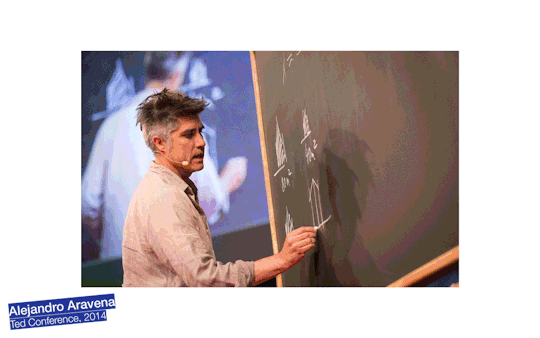

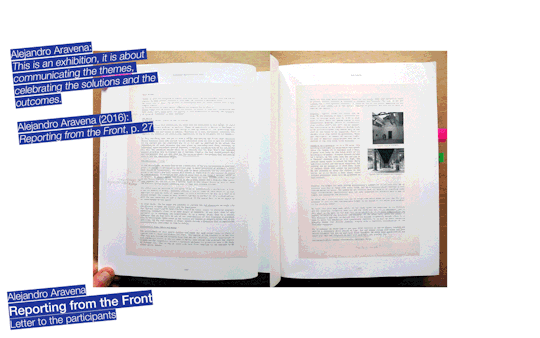
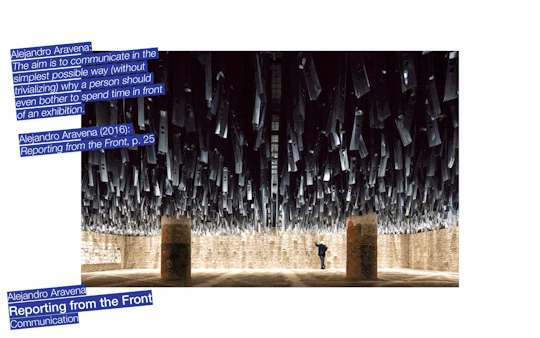
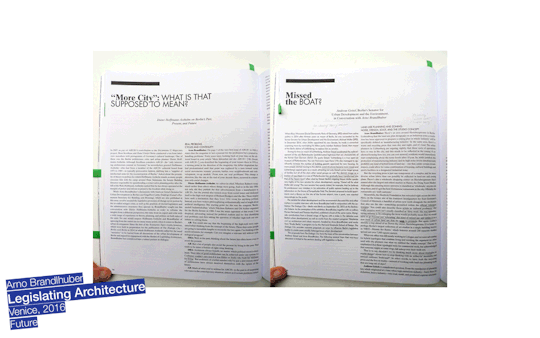

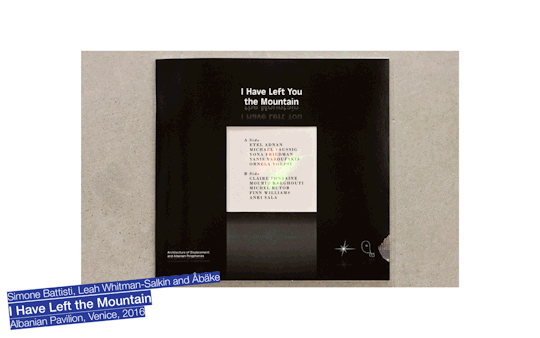
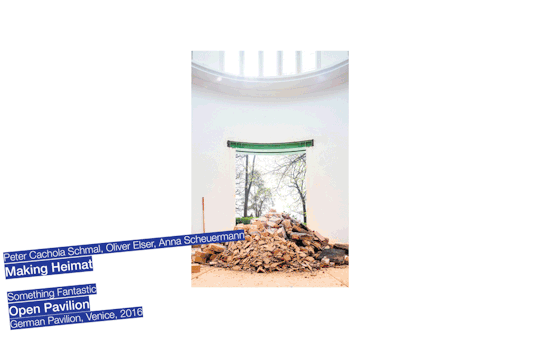
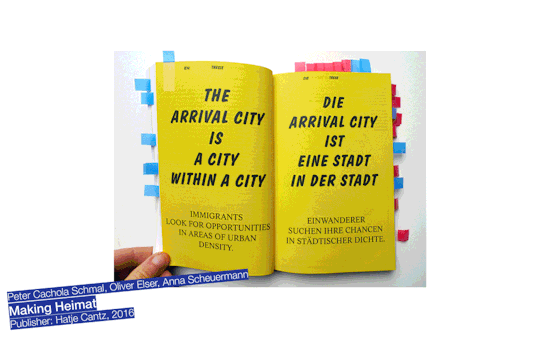
Look at and Download the slideshow at ISSUU
Presented by Enrico Forestieri at Newcastle University, Alternative Practive Theory APL 2001 (Prof. Andrew Law, Julia Heslop) 20170227
0 notes
Text
Statement - Forestieri Pace Pezzani

Statement is a magazine entirely made of “mission”, “philosophy” and “about” texts found on websites of architecture offices from all over the world. Statement is made by copying and pasting, without any kind of editing – even typos are left as they are. When available, English translations are privileged, otherwise any other original language is accepted.While electronic texts are always potentially transformable – or removable – Statement appropriates whatever is present on the web at a precise time, and it irrevocably fixes it on the materially stable support of paper. This change of format prevents any future operation of digital reproduction: by cutting the relation between a text and its contexts, Statement subverts the inherent hypertextuality and volatility of textual web contents. Quoting Bourriaud’s famous essay, Statement’s post-productive attitude consists in the invention of new “protocols of use” for pre-existing “formal structures”. The scope of such operations is not so much to interrogate pre-existing meanings, as to “inhabit” pre-existing forms in order to produce unprecedented effects ¹. The different statements are graphically homogenised and made anonymous through erasures so as to lose any sense of hierarchy – and avoid copyright infringement. This operation of “enstrangement” allows to focus on the pure literary quality of the statements – facilitating comparisons among different themes, registers and metrics.

Statement is a multimedia project that revolves around a printed magazine. Every issue comes in A5 format in fifty numbered copies, and it comprises twenty-five saddle-stitched statements digitally printed in black and white: the zero-grade of publishing. Windsor & Newton paper colored covers and Canson tracing paper jackets are the only frills. The printed magazine is distributed in some of the best libraries, bookshops, universities, architecture offices, galleries and public toilets in the world. Given the pirate nature of its content, the distribution takes place through alternative means: a network of friends-turned-volunteers-couriers periodically drop copies in selected locations and take a picture to document the delivery. The availability and exact location of the delivered copy is subsequently notified on the magazine’s blog, so as to give interested blog readers a chance to grab it for free. However, the temporality of such notifications is somewhat similar to that of electronic texts on the web: no one can guarantee that someone else won’t take the free copy in advance, that a diligent librarian won’t collect it, an astute bookseller won’t sell it or a cleaner won’t throw it in the bin. A map published on the blog provides a real-time overview of all the locations where free copies have been distributed: from the slick AA bookshop to Alvaro Siza’s austere Porto library, from Motto’s hipster fanzine sanctuary in Berlin to the more institutional bookshop at the Centre Pompidou in Paris. In addition to that, the blog hosts Radio Statement: an audio archive where the different statements are read out loud by an electronic voices. As printed copies sells out – or get lost in the world – Radio Statement progressively substitutes them as an atypical, non editable, non retrievable digital archive. Statement deliberately short-circuits the relationship between digital and material supports: it turns words into pure image and ephemeral sound.
note:
1 - Bourriaud, Nicolas, Postproduction. Culture as Screenplay: How Art Reprograms the World. (New York: Lukas & Sternberg, 2002), pp. 17-18.
more info:
https://goo.gl/eEHjMs
http://thisisthestatement.tumblr.com/
Qui trovate il testo completo
Aquí, podéis leer el texto completo
Here, the complete text
Text by Enrico Forestieri, Matteo Pace, Pietro Pezzani
published in L. Mandraccio, G. Porcile (2017), Clip Stamp, Upload
Burrasca Publisher

1 note
·
View note
Photo
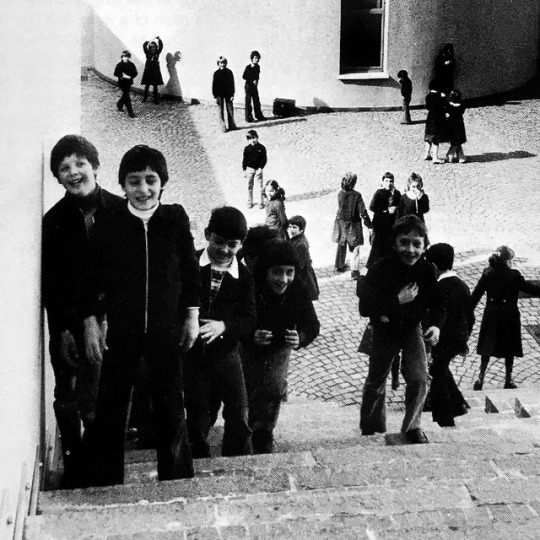
Unfolding Pavilion 2018
The Authors
The most unique members of the Little Italy network have been invited to take part in the 2018 iteration of the Unfolding Pavilion. They are Italian architects born in the 1980s, practicing also as academics, critics, artists, photographers, curators, editors or designers.
abacO is a Paris-based collaborative design studio established by Alice Braggion and Alessandro Carabini, working at the intersection of space, technologies and art.
ANALOGIQUE is an architectural practice founded in Sicily in 2015 by Claudia Cosentino, Dario Felice and Antonio Rizzo, working in the fields of architecture, landscape and urban design, furniture production and curatorial practice.
Arcipelago is a collective of islands scattered in the sea of architecture. A submarine volcanic eruption in the Adriatic Sea formed these six islands along the coast of Puglia in the spring of 2015. Since then, the plate movements on the lithosphere have caused the continuous migration of the islands throughout the Eurasian continent. These days, they are scattered all over Italy, Switzerland and Spain; some of them have just reached the Venetian lagoon to join the Unfolding Pavilion. These Islands are: Nicola Dario Baldassarre, Pasquale Cipri, Salvatore Dentamaro and Nicoletta Faccitondo.
atelier XYZ, based in Brescia and Porto, works and researches in architectural photography and architectural video. The atelier was founded in 2017 by Nicolò Galeazzi and Stefano Di Corato.
Babau Bureau is an architectural and landscape office founded in 2012 in Venice by Marco Ballarin, Stefano Tornieri and Massimo Triches. Babau Bureau’s current research focuses on the reuse and transformation of buildings and open spaces as a contemporary requirement and as a sustainable development strategy. Beside the professional career, the office keeps an active research in the academic field in the IUAV Venice.
Diego BEGNARDI graduated in Architecture at the Polytechnic of Milan. He worked mainly as an interior and furniture designer. From 2017 he follows set design courses to develop manual skills and craftsmanship, making creativity its main action field.
Giovanni BENEDETTI graduated in Architecture at the Polytechnic of Milan. He lives in Madrid, where he works and carries on personal researches about architecture. He writes and draws on his blog using the pseudonym of Muto.
Boano Prišmontas is a young London-based architectural firm, founded by Tomaso Boano and Jonas Prišmontas. They like to play, craft, design, make, doubt, investigate, and challenge themselves and the world. Boano Prišmontas took part in the London Festival of Architecture 2016 with an installation called Minima Moralia; Milan Design Week 2017 with Quiubox and Dubai Design Week with Aidah.
Bunker is a design and research studio led by Carlo Gandolfi and Roberto Molteni, operating between Milan, Venice, Lisbon, and Sao Paulo. Bunker’s formation has a variable structure, availing itself through the years of internal and external collaborations, realizing designs, winning contests, and gaining acknowledgements both in Italy and abroad. Bunker has been involved in important urban regeneration projects such as the center of artistic and cultural production "mare culturale urbano" in Milan.
Campomarzio is an architectural collective practice which merges practical and theoretical expertise within the fields of architecture, urbanism, research, and visual communication. Founded in Trento in 2012, Campomarzio is run by six partners: Pietro V. Ambrosini, Michele Andreatta, Alessandro Busana, Daniele Cappelletti, Enrico Lunelli and Teresa Pedretti. The plurality of its founders and their different international academic and professional experiences allow Campomarzio to develop a careful and meticulous design and research activity, with the aim to combine theory and practice.
Fabio CAPPELLO is M.Arch (DiARC - University of Study of Naples ‘Federico II’), assistant at DiARC and at the international seminar Villard de Honnecourt. Cappello is a licensed architect, co-founder of PROFFERLO architettura, curator at SPONTANEOUS, editor of Chiasmo (leaflet about Neapolitan architecture) and architectural photographer. He collaborated with Domus, Temporary Office, Milan Arch Week and the Venice Architecture Biennale.
Michele D’ARIANO SIMIONATO has an MA in Architecture from the University of Ferrara and a Master in Spatial Design from ZHDK in Zurich. His work focuses on temporary architecture, urban regeneration and social practice.
Roberto DAMIANI has a PhD in Architecture and Urbanism from the Università di Pescara and is currently serving as a Postdoctoral Fellow at the John H. Daniels Faculty of Architecture, Landscape, and Design at the University of Toronto. He is the organizer and curator of Italy under Construction, a program of public lectures and exhibitions on contemporary architecture in Italy sponsored by the Italian Cultural Institute in Toronto. He is the editor of the forthcoming book The Architect and the Public: On George Baird’s Contribution to Architecture (Macerata: Quodlibet) supported by the Graham Foundation.
ECÒL is an architecture office and research platform founded in 2016 in Prato, Italy. Fading the line between architectural practice and theory, its work concentrates on developing multidisciplinary collaborations promoting an inclusive approach to architecture. ECÒL believes in the definition of pure geometry as an accomplished architectural gesture, an immediate spatial producer; looking for a new iconography rich of symbolism, ECÒL uses geometry as a tool to address intuitively human reactions and to trigger spontaneous social engagement.
ENTER Studio is an architectural cooperative practice based in Genoa, Italy, founded in 2017. Enter believes in schemes where interaction, intersection and negotiation become the foundation of a work model where the exchange of skills is the surplus value. Enter aims to apply a multidisciplinary approach that believes in the variety of scales and society interaction as a key to interpret the role of the architect in contemporaneity.
False mirror office gathers five architects who have the Polytechnic School of Genoa as a common background. Believing that new only originates as a reaction to the existing, false mirror office re-discovers the past as the present, re-signifies high as mass culture, re-values forms and functions. As a matter of fact, false mirror office mis-represents Architecture.
Sara FAVARGIOTTI is Assistant Professor of Landscape Architecture at University of Trento as well as Research Affiliate at the Office for Urbanization, Harvard GSD. Graduated with distinction in 2009 (University of Genoa), she completed her PhD in 2014 (IUAV). Her research and teaching focus on landscape’s transformations and adaptation. She is specialized in landscape urbanism and ecological design focusing on emerging infrastructures and their influence on cities, landscapes and territories.
Rossella FERORELLI obtained a PhD at the Politecnico di Milano with Luca Molinari, with a thesis about the transformation of publicness in the built urban environment of the postdigital society. Since 2011, she is a founding member of SMALL - Soft Metropolitan Architecture & Landscape Lab, an architecture office and open platform based in Bari and Milan, investigating on the contemporary urban condition both through design and forms of parallel research, hybridizing the curatorial practice with independent publishing and academic experimentation.
Davide Tommaso FERRANDO is an architecture critic, editor, curator and educator based in Torino, Italy. M.Arch in Advanced Architectural Design at ETSA Madrid and Ph.D in Architecture and Building Design at Politecnico di Torino. He’s been adjunct professor at ETSA Madrid, Politecnico di Torino and Università di Ferrara, and an invited lecturer, among others, at ETSA Madrid, Politecnico di Milano and Innsbruck University. He is director of 011+ and editor of Viceversa. His texts are published in international magazines and collective books.
Figura/Sfondo is a creative workshop led by Michele Brusasca. Founded in Paris in 2010, it creates and develops poetic and ingenious objects using both traditional and new digital technologies.
Forestieri Pace Pezzani is an architecture firm based in Milan. The office was founded in 2013 by the architects Enrico Forestieri, Matteo Pace Sargenti and Pietro Pezzani. It deals with projects of different sizes, from private commissions for interiors to masterplan competitions.
gosplan believes in architecture as a mass medium. As such, architecture is a production of forms, a tale about space. gosplan was established in Genova in 2010 by Federico Bellegoni, Nicola Lunardi, Veronica Rusca and Lorenzo Trompetto.
LINEARAMA is an architectural studio and research lab established in Genoa in 2014 by Gabriele Molfetta and Selene Vacchelli.
Malapartecafé is a research project born in Genoa, Italy and currently led by Ilaria Caraffi and Emanuele Crovetto. They make drawings, satire, and stuff about architecture and contemporary culture.
Luigi MANDRACCIO is an architect and a Ph.D. candidate at dAD, Polytechnic School of Genoa and his research is focused on scientific mega-structures. He is part of the editorial board of the international books series Burrasca that he founded in 2013. He co–curated the 2015 and 2016 edition of the symposium “Clip Stamp Upload” about independent publishers on Architecture. Besides publishing some articles and essay, he co-edited: CSU Editoria indipendente di architettura nei seminari Clip Stamp Upload, and Temporary Office. First act. Il Mercato del Pesce di Genova (2017, Sagep).
oblò - officina di architettura is an architecture practice based in Milan and Paris, led by Francesca Coden and Emanuele Romani.
Giacomo PALA is an architect and researcher working and teaching at the Institute of Architectural Theory of the Faculty of Architecture in Innsbruck. He is conducting a PhD on Giovanni Battista Piranesi as a case study to develop a theoretical inquiry about the notions of contemporaneity, history, narrative and “parachronism” in architecture. He is co-directing the studio “ArchiFIcture” at the University of Innsbruck. SInce 2013 he is a member of Burrasca.
pia is an architectural practice based in Genoa, led by Alessandro Perotta and Valeria Iberto.
Gabriele PITACCO graduated cum laude, obtained a PhD and a master at the International School for Advanced Studies, won the Leonardo da Vinci grant, the Erasmus Young Entrepreneur grant and the DIANET postdoc grant. After working for OMA and OBR, Pitacco founded GPA in 2009; the firm designed the Eko Kampus masterplan in Saranda (Albania), the Hydrodinamic Museum in Trieste (Italy) and was selected (with Libeskind, Miralles-Tagliabue, LAND, Culd and Co+E) for the Kodrina maserplan in Pristina, Kosovo.
Gian Luca PORCILE received his PhD in Architecture from the University of Genoa in 2011. His main research interests are the influences of natural patterns on architectural theory and urban development. He is a founding member of the Multidisciplinary Research Group ‘ICAR65′. He teaches History of Architecture at the department of Architecture-Design (dAD) of the University of Genoa.
Giuseppe RESTA received his Ph.D. in Architecture from Politecnico di Bari/Università RomaTRE. He is co-founder of PROFFERLO architettura and curator at Antilia gallery. His research is focused on contemporary Mediterranean domestic space.
ROBOCOOP is an urban art duo composed by two architects, currently living between Rome and London. Working mainly in the urban context of the city, their aim is to document the architecture comparing it to the past, using different tools – as collages, installations, photographs, engravings, drawings etc - with a provocative and reflexive approach.
Emilia ROSMINI PhD, architectural researcher and designer, teaching assistant in various courses of Urban and Architectural design, in recent years she attended international competitions, congresses, festivals and architectural events, receiving prizes and mentions. She carried out research at ETSA Seville in 2013 and at ETSA Madrid in 2017, focusing on the relationship between social inclusion, experimental housing and built heritage. Italian by birth, Spanish by adoption, she moves between Rome, Seville and Madrid.
Giorgia SCOGNAMIGLIO is an architect and urban designer from Rome, currently attending a MSc in Urban Regeneration at UCL in London. Her research mainly focuses on the themes of urban governance, community engagement and the design and management of public spaces. With an experience of professional consultancy and academic research and teaching at Sapienza University of Rome, she has collaborated as ideator and designer with different experts on regeneration projects. She is co-founder of Unsent Postcard.
Jörg STANZEL is an architecture student, designer and researcher living and practicing in Innsbruck. His current architectural research deals with the notions of real and fake as concepts influencing the discipline of architecture (as a practice, object or ideal). He has held workshops and seminars at the faculty of architecture of Innsbruck and he is part of the Institute of Urban Design’s team at the same university.
Caterina STEINER has an MA in Architecture, from the University of Firenze. She has taught at UNITEC in Auckland, SDU in China and worked as an architect in Basel, Zurich and Milan.
STUDIO associates is the architectural practice of Marco Formenti, Nicolò Galeazzi and Martina Salvaneschi. It is an abstract and anonymous container, which by its nature, refuses a precise definition and adjectivization. It does not focus only on the final result, the product, but rather on the process that lead to that result. Thus, nothing is static and definite. Everything is constantly evolving...
StudioERRANTE Architetture is a Turin based office founded by Sarah Becchio and Paolo Borghino. Errante Architetture is particularly interested in the narrative and poetic side of the project through the use of simple construction methods, raw materials and naked details. The only way Errante Architetture knows to pursue the project is making models and drawings.
Studiospazio is the architectural practice established in 2014 by Samuele Squassabia, Tao Baerlocher and Eugenio Squassabia in Zurich (CH) and Mantova (IT). Studiospazio deals with the question of the relationship between architecture and the contemporary reality through projects, competitions, publications and the academic commitment.
TCA THINK TANK is a platform based in Singapore. Led by Pier Alessio Rizzardi, TCA is practicing architecture, urbanism and cultural analysis. TCA’s works include a variety of projects from city scale level, portable and temporary design, to printed publications. Working with architects, artist, publishers, and universities, TCA escapes from the constraint of the division between research and practice, to explore the multidisciplinary possibilities of architecture. TCA reports the Theoretical Condition of the Architecture.
Davide TRABUCCO is an artist and architecture student from Bologna, Italy. In 2012 he won a place in the residence program of Fondazione Collegio Artistico Venturoli di Bologna. He is the author of the ongoing visual project Confórmi (le forme non appartengono a nessuno).
UNO8A is an architecture team founded in Genoa in 2014 by Beatrice Moretti and Fabrizio Polimone. Since 2018, UNO8A is part of casana, a collective of architects based in Genoa.
Riccardo M. VILLA is Assistant Researcher at the TU Wien and a member of GIZMO. His latest work, Backstage: l’architettura come lavoro concreto (Hoepli, 2016) deals with the state of the practice and the conditions of labor in contemporary architecture.
WAR (Warehouse of Architecture and Research) was founded in Rome in 2013. Its essence lies between the concept of a mannerist architecture studio and an independent space for research in the contemporary practice. The studio is led by Gabriele Corbo, Jacopo Costanzo, Valeria Guerrisi.
Emiliano ZANDRI is an architect based in Rome and is teaching assistant in Urban and Architectural design at the Sapienza University of Rome. In 2016 he co-founded ZA², a brotherhood photographic project. As architect, he took part in several international competitions, workshops and architectural exhibitions.
Lorenzo ZANDRI is an architect-photographer-artist, currently living between Rome, Paris and London. His visual research has the aim to document the built environment and urban transformations, using photography as the main tool to represent the surrounding landscape. He is co-founder of ROBOCOOP, ZA² and Unsent Postcard.
ZarCola Architetti is a Milanese architectural practice founded by Edoardo Giancola and Federico Zarattini.
Illustrations: 1. Gabriele Basilico, Pupils playing in the courtyard of Aldo Rossi’s school in Fagnano Olona. Source: Gianni Braghieri, “Aldo Rossi: Works and Projects” (Barcelona: Gustavo Gili, 1991).
0 notes
Photo
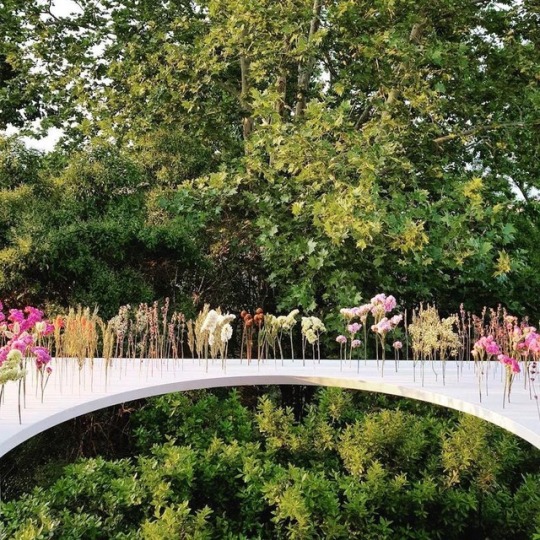
Unfolding Pavilion 2018
The Works
The Unfolding Pavilion has invited the most unique members of the Little Italy network to create works capable of reacting to both Gino Valle’s building and the specific space occupied by the Pavilion.
The invited architects were asked to produce original objects/installations, that puts in dialogue their personal body of work to the Giudecca Social Housing - to one or more of its elements/spaces/representations, to the whole building, to the relation of the project with its urban surroundings, etc. - and so to use the Venetian condominium as a sort of tool to reflect on their own practice, just as the representations of Renaissance ideal cities served as tools to experiment with the new technique of perspective.
abacO Venise qui Parle. Photography installation. 19 panels, 40 x 30 cm (each). Team: Alice Braggion, Alessandro Carabini.
ANALOGIQUE M.I.Mo. Installation. Steel device on wheels, map, image, drawings texts. Team: Claudia Cosentino, Dario Felice, Antonio Rizzo.
Arcipelago Reflektor. Box of methacrylate panels, three bricks, mirrors. Custom support in black painted steel (rod, assembled in two pieces, and two end plates). 31 x 31 x 31cm (box). 31 x 31 x 161cm (overall). Team: Nicola Dario Baldassarre, Pasquale Cipri, Salvatore Dentamaro, Nicoletta Faccitondo.
Babau Bureau Periscopio. Digital print on paper. 50 x 76 cm. Team: Marco Ballarin, Stefano Tornieri, Massimo Triches, Sofia Sacchini.
Boano Prišmontas 165x165. Light installation. Team: Tomaso Boano, Jonas Prišmontas.
Bunker Immersions. When Palladio met Valle. Installation. Bathtub, light projection, water. 48,5 x 30 x 8 cm. Team: Carlo Gandolfi, Roberto Molteni, Federico Chaubet, Matteo Donghi.
Campomarzio Hamlet, The Ghost of the Cemetery of the Ashes of Thought. Installation. Direct print on glass, digital print on paper. 300 x 70 cm. Team: Pietro V. Ambrosini, Michele Andreatta, Alessandro Busana, Daniele Cappelletti, Enrico Lunelli, Teresa Pedretti.
Fabio CAPPELLO, Giuseppe RESTA Domestic Valle. Installation. Custom ‘Udine’ wallpaper, custom ‘Chirignago’ steel table. 30 sqm (wallpaper). 175 x 75 x 70 cm (table). Team: Fabio Cappello, Giuseppe Resta.
Fabio CAPPELLO + Rossella FERORELLI + Luigi MANDRACCIO + Gian Luca PORCILE CSU in Motion. Event. Round table & discussion. Sunday, May 27th 2018, 10:00 - 13:00. Team: Fabio Cappello, Rossella Ferorelli, Luigi Mandraccio, Gian Luca Porcile.
Michele D’ARIANO SIMIONATO & Caterina STEINER Abandon Ship! Installation. Sound, laser printed images on paper. 170 x 170 cm. Team: Michele D’Ariano Simionato, Caterina Steiner.
Roberto DAMIANI Hotel Giudecca 2028. Color prints on Sintra panel, 33 x 33 cm (each). Color booklet, 22 x 28 cm. Team: Roberto Damiani, Emma Dunn, Mina Hanna, Zoe Renaud.
ECÒL La Serenissima. Iron, PVC, PLA, acrylic. 75 x 75 x 60 cm. Team: Emanuele Barili, Cosimo Balestri, Olivia Gori, Lorenzo Perri (architects), with the fundamental support of Flavia Monechi (designer) and Vanni Balestri (oral surgeon).
ENTER Studio Del Gabinetto (e) delle Allegorie / Upon the Chamber (and) of Allegories. Installation. Paper. 16 sqm. Team: Margherita Del Grosso, Massimiliano Dalle Sasse, Alessio Poggi, Andrea Silvestri, Chiara Mondin.
False Mirror Office, gosplan, LINEARAMA, pia, UNO8A La Cameretta / The Kids Room. Installation. Colored medium density fiberboards. 175 x 35 x 95 cm. Team: False Mirror Office (Andrea Anselmo, Gloria Castellini, Filippo Fanciotti, Giovanni Glorialanza, Boris Hamzeian), gosplan (Nicola Lunardi, Veronica Rusca, Lorenzo Trompetto), LINEARAMA (Gabriele Molfetta, Selene Vacchelli), pia (Alessandro Perotta, Valeria Iberto), UNO8A (Beatrice Moretti, Fabrizio Polimone), with the carpenters team 81 millimetri (Ivan Berton, Lucia Lina Repetto) and the support of ALL WOOD & Special Materials (Genova).
Davide Tommaso FERRANDO + Sara FAVARGIOTTI Little Italy: The Survey. Video. Booklet. Team: Davide Tommaso Ferrando, Sara Favargiotti, with graphic design by Martina Moro & Paul Böhm, sponsored by Land Tirol, in collaboration with Italien-Zentrum - Innsbruck University.
Forestieri Pace Pezzani Competitions as Battlefields: Imaginary Landscapes, The Quality Myth, Is Time Money?. Event. Round table & discussion. Saturday, May 26th 2018, 15:00 - 19:15. Team: Enrico Forestieri, Matteo Pace Sargenti, Pietro Pezzani.
Malapartecafé + Fabio CAPELLO THE SUSTAINABLE MISUNDERSTANDING or WE DON’T GIVE A S*** ABOUT SUSTAINABLE IMPERATIVE IF IT’S ONLY ANOTHER ORNAMENT TO ARCHITECTURE. Digital print. Customized toilet paper. 20 x 20 cm. 10 x 10 x 12 cm. Team: Ilaria Caraffi, Emanuele Crovetto, Fabio Capello.
oblò - officina di architettura + Figura/Sfondo Opus Incertum. Installation. Wood trunk, mirror, 3d printed brick. 60 x 60 x 60 cm. Team: Oblò – Officina di Architettura (Francesca Coden, Emanuele Romani), Figura/Sfondo (Michele Brusasca), Alessandro Benetti with Volumes Makers Space (Paris).
Giacomo PALA + Riccardo M. VILLA + Jörg STANZEL Quasi Theory - Quasi Project. Multimedia. 60 x 100 x 180 cm.
Gabriele PITACCO Unfolding Young (!?) Gino Valle. Installation. 5 digital printed panels, 12 postcards, text. 3d printed maquette. 314 x 250 x 82,5 cm (overall). Event. Round table & discussion. Saturday, May 26th 2018, 11:00 - 13:00. Team: Alessandro Bettoso, Claudia Ciulla, Cristina Forcesin, Enrico Furlan, Marco Gnesda, Gabriele Pitacco, Irene Valle.
ROBOCOOP Souvenir from La Giudecca. Kitsch-pop installation. Hand-made collage and digital print. Snow globe with paper, glass, glue, plastic, water, marble, brass. Wooden podium. 18 x 18 x 9 cm (object).
Emilia ROSMINI & Emiliano ZANDRI THE MAIL. Plexiglass and paper. 30 x 20 x 12 cm.
Giorgia SCOGNAMIGLIO & Lorenzo ZANDRI Greetings from an apartment (Unsent Postcard). Installation. Bespoke plywood shelves. Limited edition postcard series, 4���x6’, 400gr glossy paper, printed in Italy. 150 x 75 cm (overall).
STUDIO associates + atelier XYZ + Davide Tommaso FERRANDO Democratic Spaces. Movie. Event. Film screening & discussion. Saturday, May 26th 2018, 20:30 - 21:30. Team: STUDIO associates (Marco Formenti, Nicolò Galeazzi, Martina Salvaneschi), atelier XYZ (Stefano Di Corato), Davide Tommaso Ferrando.
StudioERRANTE Architetture + Diego BEGNARDI + Giovanni BENEDETTI Banchetto / Feast. Papier-mâché. 130 x 60 x 100 cm. Team: StudioERRANTE Architetture (Sarah Becchio, Paolo Borghino, Ioana Iacob), Diego Begnardi, Giovanni Benedetti.
Studiospazio Giudecca Windowsill. Painted plywood, dry flowers. 90 x 187 x 2,5 cm. Team: Samuele Squassabia, Tao Baerlocher, Eugenio Squassabia, Diana Arina.
TCA THINK TANK + ZarCola Architetti Italian experience, foreign architects: Stories of those who pull it off. Installation. Metal, 250 x 150 x 150 cm. Book, 17 x 24cm, 220 pages. Posters, 45 x 80 cm. Video,15 minutes. Team: Pier Alessio Rizzardi, Zhang Hankun, Alessandro Colombo, Edoardo Giancola, Federico Zarattini.
Davide TRABUCCO Versus II. Fabric. 200 cm x 300 cm.
Unfolding Pavilion An Exhibition of Social Value. Performance. 60 hours. Team: Daniel Tudor Munteanu, Ana Munteanu, Davide Tommaso Ferrando, Sara Favargiotti, Magda Vieriu & Octavian Hrebenciuc.
WAR (Warehouse of Architecture and Research) Theseus in the 80’s. Light Installation. LED strips, disco ball. 100 m strip. 50 cm ø ball. Team: Gabriele Corbo, Jacopo Costanzo, Valeria Guerrisi, Loriano Giannone, Michelangelo Sicari, Angela Tanzola.
All of the exhibited works were commissioned by the Unfolding Pavilion and were created especially for this exhibition.
Illustrations: 1. Studiospazio - Giudecca Windowsill. Photo by: Davide Tomasso Ferrando. © Unfolding Pavilion.
1 note
·
View note
Photo

Forestieri Pace Pezzani
Competitions as Battlefields
For most architectural practices, competitions constitute one of the most common ways to try to get some work. In fact, the extremely low odds of victory – and, as a consequence, of paying back expended labor – and the even lower chances of building winning schemes, don’t seem to discourage the hundreds competing every day for the most ambitious or interesting briefs. Bolstered and trained by the rhythms and formats of university studio projects, young architects see competitions as unique opportunities to engage with complex programs and public clients that would otherwise remain inaccessible. Due to their tight temporality, competitions boost the production of architectural collective imagination. The imminence of deadlines releases inhibitions and favour a form of “automatic writing”, through which radical approaches and pragmatic and/or opportunistic tactics can be freely – and relatively quickly – experimented. However, the cutthroat selection of the proposals doesn’t always honour the most interesting or innovative ones. Yet the riskiest proposals – often misinterpreted, misunderstood or deliberately covered up by the jury – earn, on their own terms, the deserved prestige which was denied during the competition stage.
However, recent transformations in the cultural, professional and economic horizons have significantly altered any well-established pattern: the contemporary scenario is characterised by an increasingly accelerated circulation and consume of images, which is causing the progressive disappearance of magazines and the rise of new platforms where a new architectural collective imagination is created and shared; while the number of architectural practices increases exponentially and competition reaches a global scale, the cultural and technical relevance of the profession has been radically downsized; finally, the shrinking of direct commissions caused by the long financial crisis, together with the rise of more measured architectural approaches in terms of scale and costs, made a large number of architects redundant.
Such structural changes seem to question the viability of competition as a tool to bring together the – frequently diverging – priorities of designers, jurors, future users and potential clients. We had invited the diverse group of participants to the Little Italy platform to contribute to this debate in the framework of the Unfolding Pavillion 2018.

1. Competitions as battlefields: Imaginary landscapes Arcipelago – architettura collettiva, Nina Bassoli / Lotus, Domenica Bona / Divisare, False Mirror Office, Angelo Renna
2. Competitions as battlefields: Is time money? Babau Bureau, Gosplan, Quinzii Terna Architetti, Riccardo M. Villa / Gizmo
3. Competitions as battlefields: The Quality Myth Carlana Mezzalira Pentimalli, Demogo, Studiospazio, Alberto Winterle / Turris Babel, Simone Tocchetti
Forestieri Pace Pezzani is an architecture firm based in Milan. The office was founded in 2013 by the architects Enrico Forestieri, Matteo Pace Sargenti and Pietro Pezzani. It deals with projects of different sizes, from private commissions for interiors to masterplan competitions.
Competitions as Battlefields: Imaginary Landscapes, The Quality Myth, Is Time Money? Event. Round table & discussion. Saturday, May 26th 2018, 15:00 - 19:15. Team: Enrico Forestieri, Matteo Pace Sargenti, Pietro Pezzani.
Illustrations: © Forestieri Pace Pezzani, Davide Tommaso Ferrando. >
0 notes